Curry Leaves Chutney Recipe
Updated: December 1, 2022, By Swasthi
Curry Leaves Chutney is a super aromatic, nutritious and tasty Chutney variety made with fresh curry leaves, spices, lentils and coconut. It is eaten with Breakfasts, Snacks and even with rice. Curry leaves chutney is also known as Karvepaku Pachadi in Telugu & Karuveppilai Chutney in Tamil. It is a staple in a lot of South Indian homes especially those who own a Curry leaf tree in their backyards or farms.
In this post I share an easy recipe to make curry leaves chutney. You can store this for about 3 to 4 days in the refrigerator.
About Curry Leaves
Curry leaves also known as Karipatta or Kadi patta are an important herb used in traditional South Indian & Maharashtrian cooking. Almost every savory dish begins or ends with a tempering of curry leaves, mustard seeds and/or red chilies.
Curry leaves not only impart a unique nutty, sweet & pungent aroma but also work as a digestive aid (if you eat them).
But unfortunately all of us end up discarding it and rarely eat assuming it to be just for flavoring.
Curry leaves are nutritious and are rich in iron, folate & many vitamins. Growing up we never realized the value of fresh curry leaves as they were grown in abundance in the backyard and farm.
A lot of the fresh leaves would be used to make this spiced Curry Leaves Powder (Karvepaku podi) and we would have the curry leaves rice on weekly rotation.
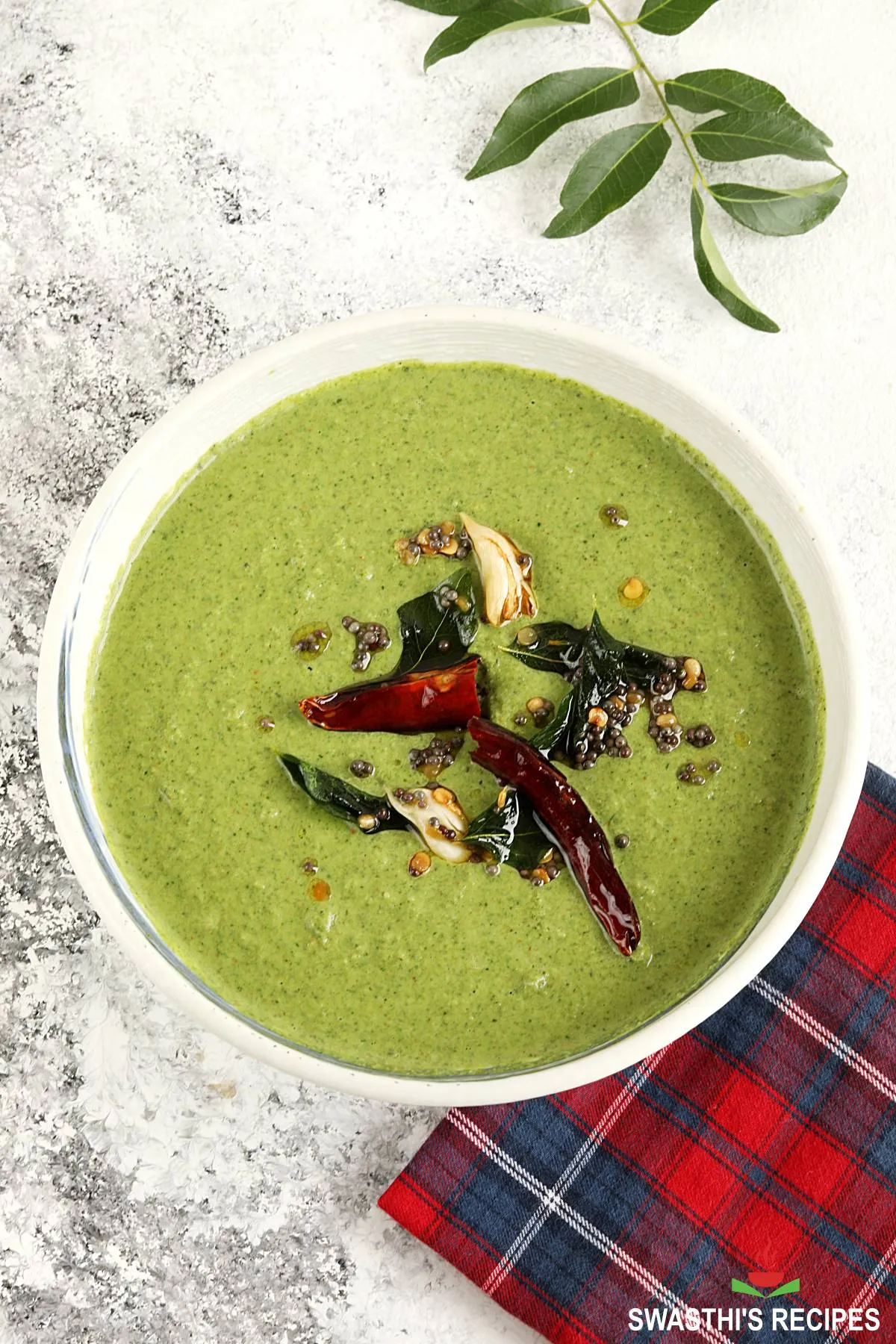
Curry Leaves Chutney is yet another way of using up the abundant fresh leaves. This chutney is not only delicious but also helps in digestion.
There are 2 ways Andhra style Karvepaku Pachadi is made. One is the thick chutney that is eaten with hot rice and ghee. The second one is this & goes well with just anything!
We usually serve this with Idli, Dosa, uttapam, Pongal, Rava idli, Pakora, parathas, Chapati, sandwiches etc. You can also smear your wraps, rolls and sandwiches with this chutney instead of a spread.
This recipe can again be made with a choice of red chilies & tamarind or with green chilies & lemon juice (for the tang). These 2 ingredients to a large extent impart their own flavors and color.
I make this recipe very often with these 2 different set of ingredients. Red chilies and tamarind impart brown to red color to the chutney while the green chilies impart green color.
More Chutney recipes
Green Chutney
Coriander Chutney
Capsicum Chutney
Ginger Chutney
Red capsicum chutney
Photo Guide
How to Make Curry Leaves Chutney (Stepwise Photos)
Preparation
1. To begin with measure 2 cups of curry leaves and rinse them well. If you are not using organic leaves, you may spray vinegar and sprinkle a bit of baking soda. Leave for 5 minutes, later rinse them well at least thrice. Drain them to a colander and shake off to get rid of the excess water.
Dry them on a cloth or pat dry with the cloth or kitchen tissues so most of the moisture is removed. I air dry them for a few hours instead of wiping them dry but it is not essential.
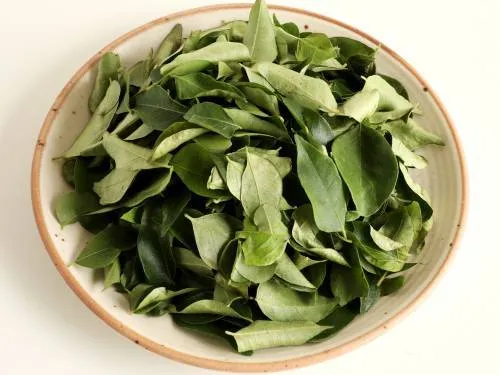
2. You will need
- 1½ tablespoon chana dal (Bengal gram)
- ¾ tablespoon urad dal (optional)
- 3 garlic cloves (or ½ inch ginger peeled & sliced)
- ¾ teaspoon cumin seeds
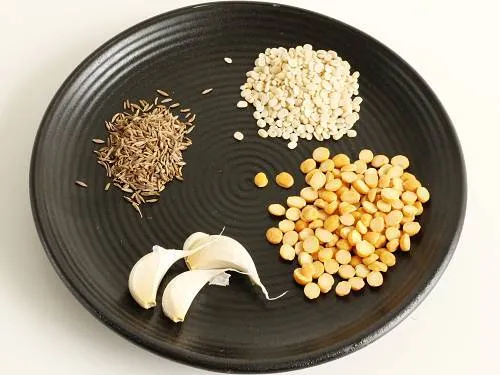
3. You also need
- 3 to 4 green chilies (Indian/Thai or serrano peppers or dried red chilies)
- 1 tablespoon lemon juice (or 1 tsp tamarind paste from 2 tsps tamarind)
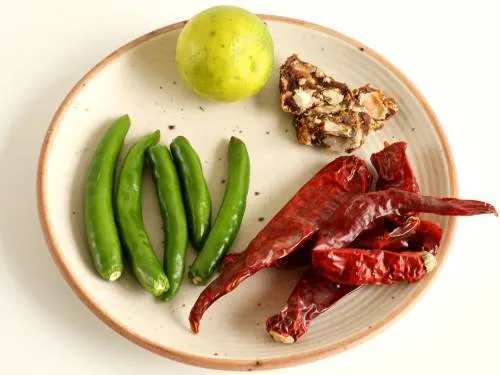
4. You also need ½ cup fresh coconut (or unsweetened shredded coconut or grated copra or shallots or sliced onions) If you don’t want to use coconut, use the same amount of shallots or sliced onions.
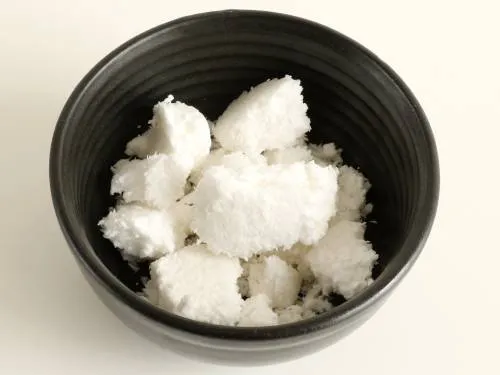
Fry the Ingredients
5. Heat a pan with half tablespoon oil. Add the chana dal, urad dal and cumin seeds. Fry them on a medium heat until light golden.
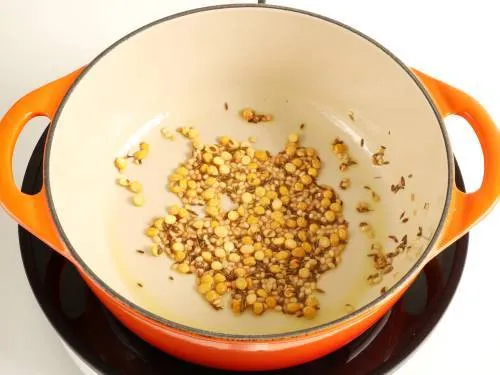
6. Add the green chilies (slit or chopped) and garlic or ginger. Fry them until the green chilies blister. Do not burn the spices. Turn off the stove and remove to a plate.
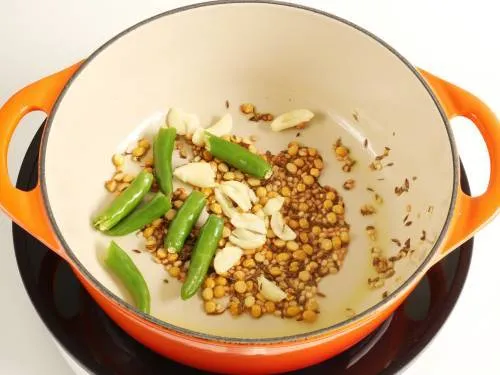
7. To the same pan, add half tablespoon oil and add the curry leaves.
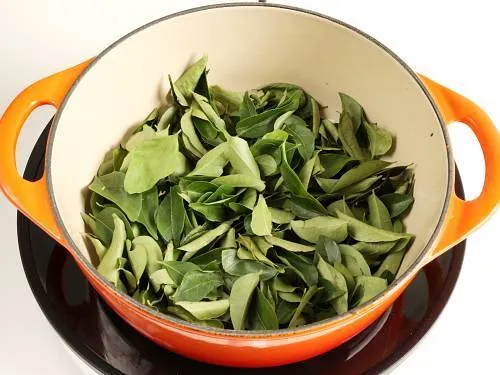
8. Fry them on a medium heat until crisp but not burnt.
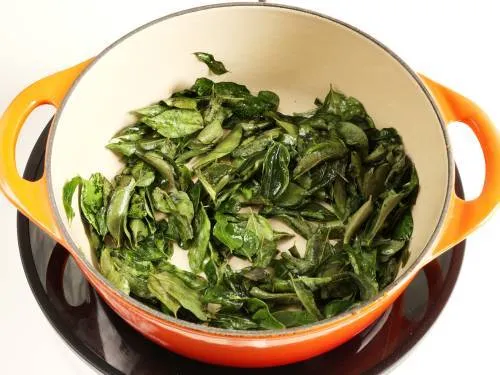
9. Add the coconut if using. (If you are using onions or shallots in place of coconut, remove the curry leaves to a plate and saute the onions in 1 tsp oil until golden.)
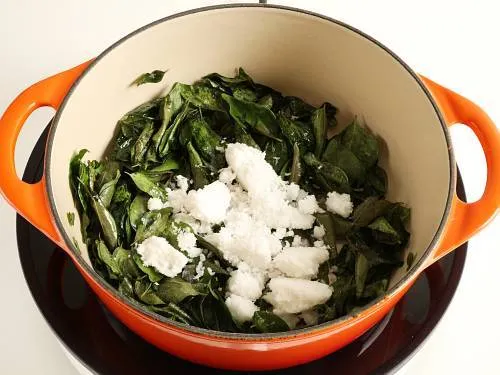
10. Stir fry for a minute or 2 until the coconut becomes hot. Turn off and cool completely.
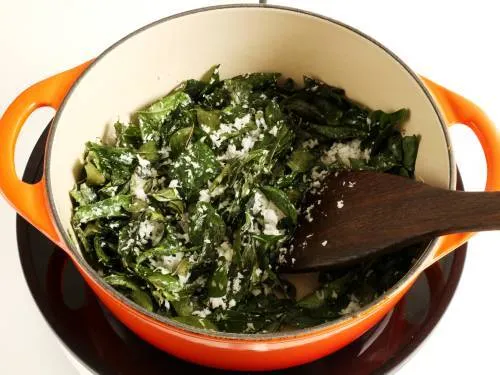
Make the Chutney
11. Add the roasted lentils, cumin, chilies, garlic, half teaspoon salt and 1 tablespoon lemon juice or tamarind. I prefer to set aside a few fried chilies and add them later while blending after taste testing.
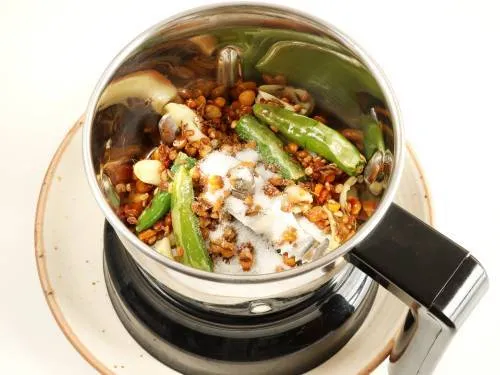
12. Add the curry leaves and coconut. Pour ¼ cup water and begin to blend. You will need about ½ to ¾ cup water, depending on the consistency you like.
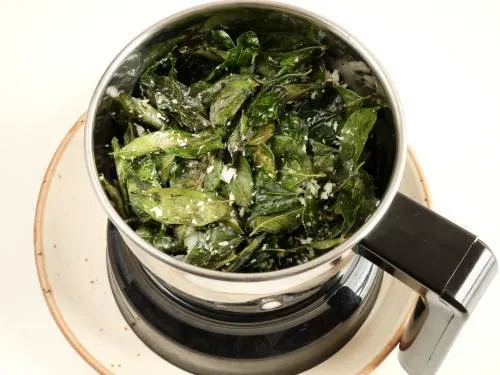
13. Blend the curry leaves chutney to a smooth texture. Taste test and adjust salt and lemon juice.
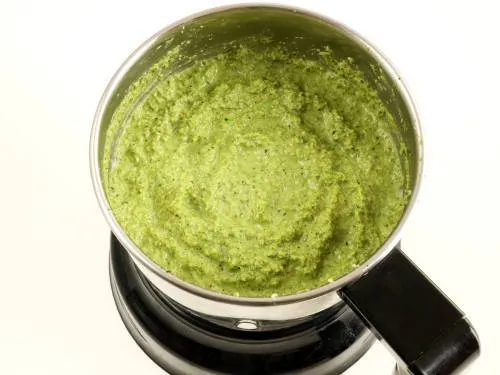
This chutney does not require tempering and most often I don’t. If you want to temper, heat half tablespoon oil in the same pan. Add a pinch of mustard seeds, 1 pinch of urad dal, 2 crushed garlic cloves, 1 broken dried chilli . When the chilies turn crisp, add curry leaves and fry until crisp. Add hing and pour this over the curry leaves chutney.
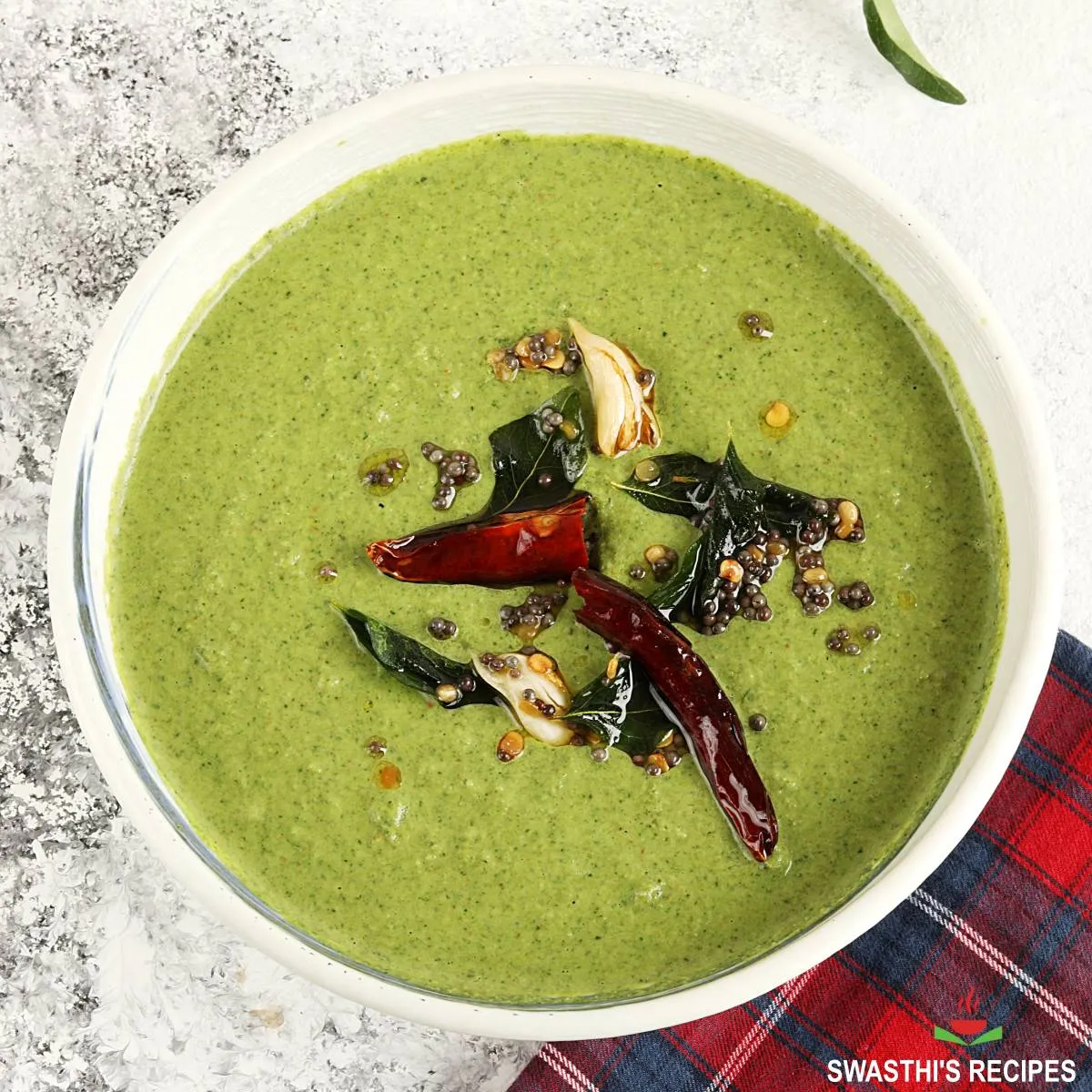
Pro Tips
Curry leaves: For those who are doubtful about the nutrients being lost in stir fried curry leaves. You can dry the curry leaves in shade for few days until they turn crisp.
Crush them up, to powder with moist free hands and store it in a glass jar. It can be refrigerated. Add to the chutney whenever needed. My Mum would dry the curry leaves in the veranda during the day for three days to dehydrate them completely, not during the monsoons since the leaves get moldy.
Chilies: You can use either fresh green chilies or dried red chilies. Both impart different flavor and color to your chutney.
Ginger or Garlic: Ginger and garlic both impart different flavors. Use whatever you like.
Chana dal: I personally prefer chana dal also known as bengal gram for our chutneys as the texture, flavor, taste and aroma are exceptionally good. However you can simply replace chana dal with roasted gram (chutney dal) or roasted peanuts.
I find one of them essential in this recipe because they impart a smooth texture to the chutney. Without dal or peanuts I felt the coarse texture of curry leaves fibers.
Tempering: Tempering is not essential for this chutney and is not a part of the recipe. I do it just for added flavor & garnishing.
This is the picture of the curry leaves chutney made with only chana dal & red chilies, no coconut is used. This is creamy, nutty and delicious!
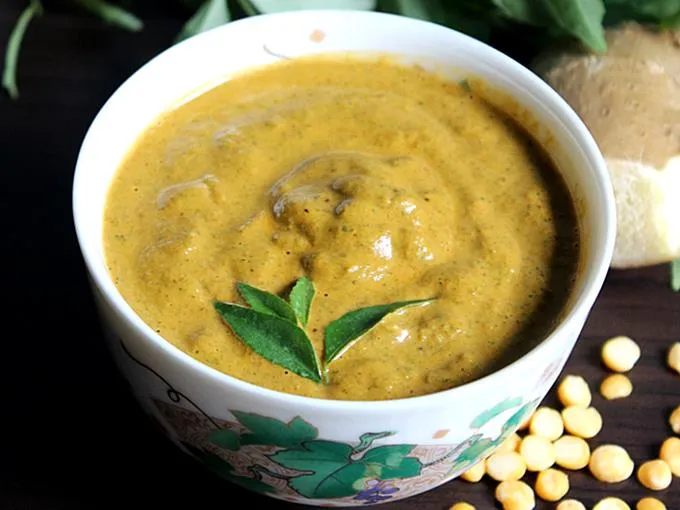
Related Recipes
Recipe Card
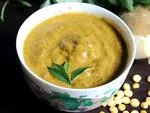
Curry Leaves Chutney
For best results follow the step-by-step photos above the recipe card
Ingredients (US cup = 240ml )
- 2 cups curry leaves (30 grams)
- 3 to 4 green chilies (Indian/Thai or serrano peppers or dried red chilies)
- ¾ teaspoon cumin seeds
- ½ teaspoon salt (adjust to taste)
- 3 garlic cloves (medium or ½ inch ginger peeled & sliced)
- 1 tablespoon oil (divided)
- 1 tablespoon lemon juice (or 1 tsp tamarind paste)
Other Ingredients (substitute with ¼ cup roasted skinned peanuts or 3 tablespoon chana dal)
- 1½ tablespoon chana dal (Bengal gram)
- ¾ tablespoon urad dal (leave out if you don’t have)
- ½ cup fresh coconut (or unsweetened shredded coconut or grated copra or shallots or sliced onions)
Instructions
How to Make Curry Leaves Chutney
- Rinse curry leaves in plenty of water at least thrice. If you are using store bought curry leaves that are not organically grown, simple spray some vinegar and sprinkle baking soda. Leave them for 5 mins. Later Rinse them in water.
- Drain them to a colander and shake off the excess water. Spread them on a cloth or kitchen tissues and wipe dry. You can also leave them to air dry for a few minutes.
- Pour ½ tablespoon oil to a pan and add the chana dal, urad dal and cumin seeds. Let the dal turn light golden. Then add the chilies and garlic
- Fry them until blistered or crisp. Remove to a plate to cool down.
- Add another ½ tablespoon oil and add the curry leaves. Fry them on a low to medium heat until the leaves are crisp but not burnt.
- Stir in the coconut and saute for a minute or 2 until the coconut turns hot.
- Cool and add to a grinder. Squeeze some lemon juice (or tamarind paste) and add salt.
- Blend all these starting with ¼ cup water, adding more up to ¾ cup in total. Taste test and adjust salt and lemon juice.
- Curry leaves chutney tastes good on its own without a tempering. But if you want you may temper it optionally & it is not a part of the recipe.
- For this heat ½ tablespoon oil in a small tadka pan. Add ¼ teaspoon mustard seeds, 1 pinch of urad dal, 1 broken dried red chili, 1 to 2 small garlic cloves and 5 to 6 curry leaves. When the leaves turn crisp, add a pinch of hing and pour this over the curry leaves chutney.
Notes
- If you want to use peanuts, you may dry roast them until golden and aromatic. Deskin them and add directly to the grinder. However note the color would be different.
- Fresh coconut helps to retain the bright green color. Leaving out coconut or using red chilies is going to alter the color of your chutney.
- Coconut can be replace with the same amount of shallots or sliced onions. Fry the onions separately in the pan until golden.
NUTRITION INFO (estimation only)
© Swasthi’s Recipes
About Swasthi
I’m Swasthi Shreekanth, the recipe developer, food photographer & food writer behind Swasthi’s Recipes. My aim is to help you cook great Indian food with my time-tested recipes. After 2 decades of experience in practical Indian cooking I started this blog to help people cook better & more often at home. Whether you are a novice or an experienced cook I am sure Swasthi’s Recipes will assist you to enhance your cooking skills. More about me
Follow Swasthi’s Recipes

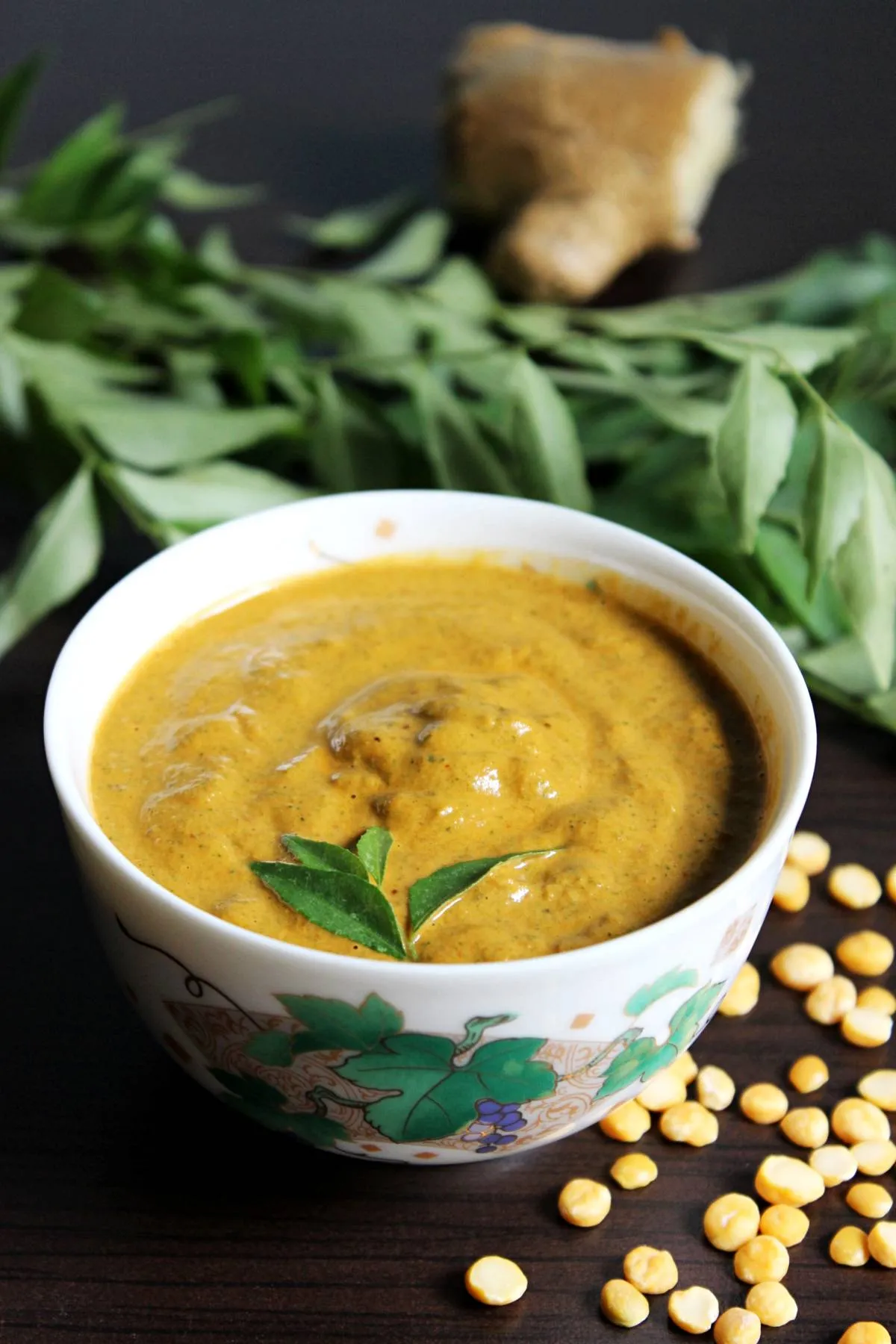
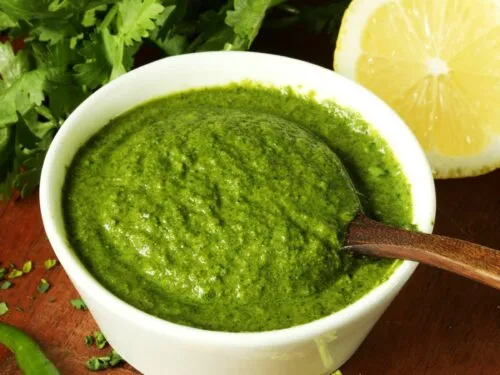
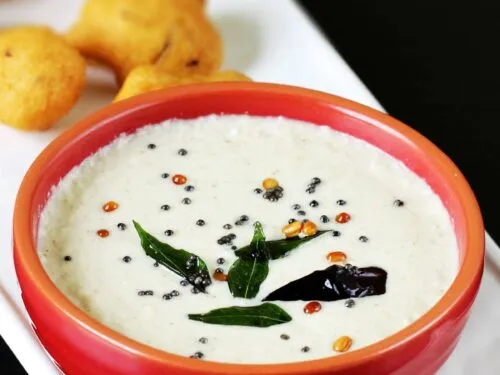
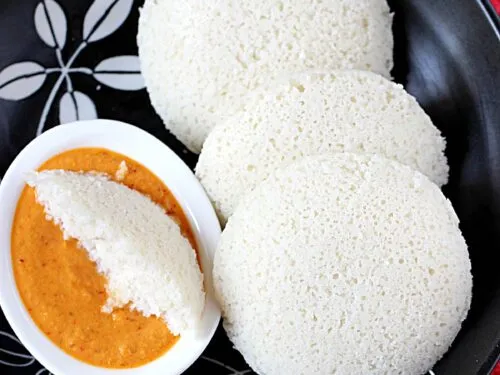
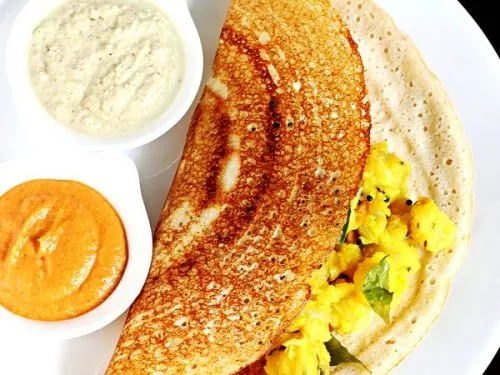
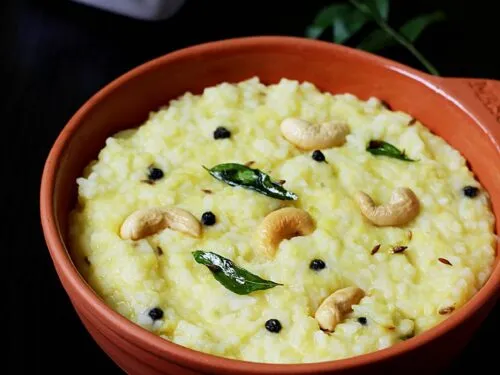
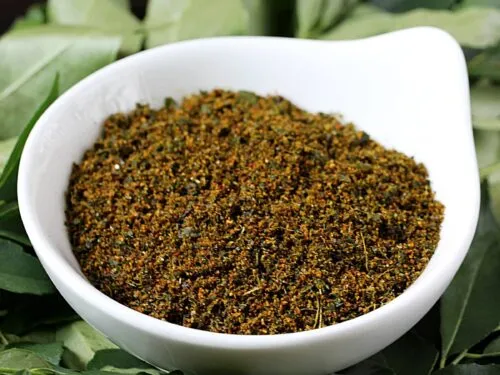
Comments
Delicious; worked perfectly on the first try.
I love this recipe! I made it for the third time today double quantities. The first 2 times my chutney was drier than your pic though it tasted really good. This time I added more water and lemon to make it a thinner consistancy. I think the flavour is not as good but still good. Each time it takes a very long time to make including picking the leaves (we have a curry leaf tree in the garden) and frying the green chillis until they blister, and the leaves until they are crisp. I am a slow cook but usually everything works out well following your tips.
Thanks Thea. Glad you like it. Yes thicker chutney tastes better. If you are making a large batch, try wilting the leaves in a oven before frying. This saves a lot time.
Thank you for the tip on wilting the leaves. Even though I tried to make it thinner it thickened again in refigerator. I think it tastes the same. Really good. I still have some in the fridge. After 3 days it is still good. I know you said it keeps 2-3 days but is it ok to use after that? Can I freeze it next time?
Yes it gets thicker after refrigerating or freezing. A general recommendation for storing/refrigerating any cooked food is 2 days/ 48 hours. I think the quality and taste begins to degrade and may not be safe for the digestive system. Most of the raw coconut we use these days is frozen and it is generally adviced to consume after thawing. No clear instructions if it can be frozen again. May be using shredded coconut is better if you want to freeze. If you just want to use up your surplus curry leaves, try this curry leaves powder. It keeps good for a long time. Hope this helps Thea.
I used shredded coconut but I prefer not to freeze. Next time I will make a smaller batch. The curry leaves powder looks good. I’m keen to try that recipe too. Thank you 🙂
Can this be made in advance & stored in the refrigerator.?
Yes. It keeps good for 2 to 3 days
Love this recipe.
Vanakkum from South Africa – Tongaat i am concerned that the fat equates to31% but you not using tonnes of oil – is the oil coming of from coconut . I also note you dont talk of the fact natural leaves has insulin when eaten raw it helps heal diabetic people .
Vanakkum Allimuthu,
Actually the fat content is 12%, not 31% and yes a major portion of that should be coming from coconut. However you may substitute coconut with 3 tbsps of chana dal or 1/4 cup roasted peanuts. Yes but speaking about the health facts is beyond the scope of a recipe. Hope this helps
Every time I visit your website I get to learn something new. This curry leaves chutney is very different and tastes so good with peanuts.
That makes me happy Vinitha. Thank you so much
I’m curious if the red chilies should be dry or fresh?
Hi Thomas,
We use dried red chilies. But you can also use green chilies or even fresh red chilies.
I faithfully follow your recipe sometimes it comes out well but when it does not it’s my mistake but thank you so so so much
Hi,
You are welcome! Great to hear that. Thank you so much for leaving a comment!
Makes me really happy.
🙂
Recipe?…will try
Thanks Urvashi. Yes do try them!
Dear Mrs Swasthiji,
I have tried many many Dishes,as I stay alone,am a foodie & Love Cooking,which is a Great art.Today I Searched your Blog,as 2 marrow am going to prepare,Dal Vada,using all three dals,i.e Moong,Urad & Chana in the proportions given by you .
I have also tried Idli’s many a times,though they were always Hard & NOT soft Spongy,though I have never ever used Idli Rava,if I am required to use that,What is the proportion of the same,with Rice ( Ordinary Rice ),what might have went Wrong? Also till date,I am Unsuccessful in making Excellent,Fully risen,Soft & Spongy,Khaman Dhokla,can you identify my Mistakes & tell me,how to rectify these,please?
Herewith wishing all the very Best to you,Your Husband & the Kids,
Shrineevas Sant,Nashik-India
Hi Shrineevas ji
Sorry for the delay.
Thank you so much for reading the blog.
Idlis turn out good with idli rice and not with raw rice as it is too starchy. If making with raw rice you will need to use aged rice otherwise they may not turn out good. You can check the idli recipe here. I will share the recipe of khaman dhokla soon. Thanks for being here.
mam r u from andhra how u knw all names perfectly ? without any mistakes u r tellng karivepaku pachadi ?
Hi Prathyusha
Yes we are telugu speaking. Thanks for reading the blog. Hope you like the recipes.
So yummy thanks for the recipe ?
Yummy taste..tried karuvepilai chutney by adding some coconut.. Yummy yummy
Thanks Priya
Yes you can add coconut
I like u r recipe’s and thanks
Welcome Vidhya
wow yummy recipes really came out wel specialy radish chutney thank u soo much
welcome Usha
simply superb
Very useful and easy receipes Thank you
Welcome Sangeeta
I lik all resepies. Tq ma
Welcome
i am happy you like the recipes.
Hi swasthi! Made this chutney and came out really well. Yes the channa dal gave a creamy texture and tasted well. Thanks a lot. Refridgerated and used for four days and tasted good also how to make the chutney pachadi style to eat with rice? Please suggest.
Hello Madhavi, iam glad you liked it. For making the pachadi for rice, we make it the same way like this beetroot chutney but without green chili. We use tamarind. Also 1 tsp coriander seeds can also be used.You will have to chop the curry leaves finely and then fry in oil till they turn crisp. hope this helps
Peanut chutney is really superb
Thank you sumathi
swasthi,its an amazing recipe…healthy n tasty aswell…everyone shud try this…I loved d taste! ! thank u fr such a healthy recipe! ! gud job!! 🙂
Thanks Khushi, iam glad you liked it.
once again thanks a lot for the feedback
🙂